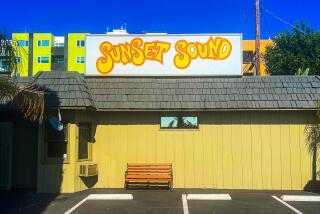EMI’s long and winding legacy
- Share via
LONDON — The four long-haired young men from Liverpool were a half-hour late when they poured into Studio Two at EMI Records on Abbey Road on June 6, 1962. They raced nervously through a ragged set of songs, while a producer named George Martin listened to the audition from the control booth upstairs. Afterward he delivered an hourlong lecture on what they needed to do to make a professional record.
The rest, as they say, is history. Despite his initial misgivings, Martin signed the Beatles to a recording contract, albeit for a rock-bottom rate. The group came back three months later to record their first single, “Love Me Do.” It peaked at No. 17 on the British charts. But their next attempt, “Please Please Me,” launched a run of 12 No. 1 singles in a row and a dozen gold albums, and the most successful pop music group in history started down the long and winding road to fame, fortune and Yoko Ono.
Ever since, the Abbey Road Studios, most especially Studio Two, have been part of the legend -- the place where, by EMI’s count, 192 of the Beatles’ 202 songs were recorded.
For years pilgrims, fanatics and the curious have traversed the crosswalk and stood outside the gates of the studios -- by EMI’s informal count, between 100,000 and 120,000 walk past each year. But except for a brief stretch in 1982, its doors have remained closed to the public.
Until now. Last Saturday, Abbey Road’s owners opened its gates for a film festival honoring the 25th anniversary of the studio’s work as one of the world’s largest producers of movie music. Nearly two dozen films are being shown over 16 days in Studio One, the cavernous room where the movie scores are performed and recorded. But for many, the main attraction is just across the hall: Studio Two is also open for festival-goers.
EMI veterans say the studio looks much the way it did when the Beatles worked there between 1962 and 1969. A soundproof iron door that looks as if it could have done service on a German U-boat still guards the entrance. Inside, white paint is peeling from parts of the acoustic panels on the walls, and the parquet floor is scuffed from hundreds of amplifiers and instruments that have been hauled over it. There are a half-dozen sets of multicolored lights that were installed at the demand of the Beatles, who felt it gave the room a warmer, more psychedelic ambience.
“You can feel the ghosts when you’re in here, and you can sense the atmosphere as well,” said David Holley, EMI’s managing director. “It’s almost as if everyone who’s ever worked here has left a sound behind.”
More to Read
The biggest entertainment stories
Get our big stories about Hollywood, film, television, music, arts, culture and more right in your inbox as soon as they publish.
You may occasionally receive promotional content from the Los Angeles Times.










